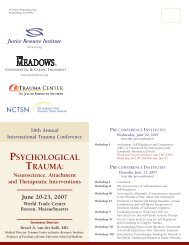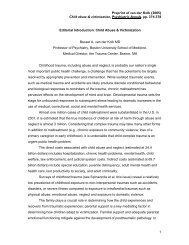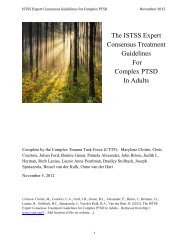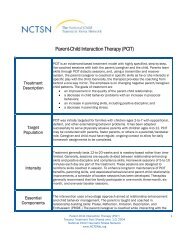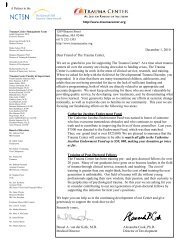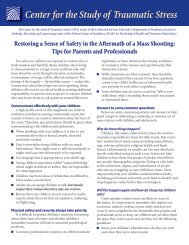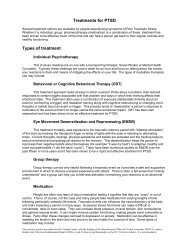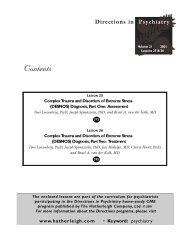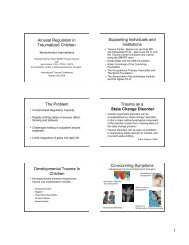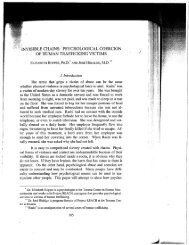in Child Welfare - The Trauma Center
in Child Welfare - The Trauma Center
in Child Welfare - The Trauma Center
Create successful ePaper yourself
Turn your PDF publications into a flip-book with our unique Google optimized e-Paper software.
12 CW360 o <strong>Trauma</strong>-Informed <strong>Child</strong> <strong>Welfare</strong> Practice • W<strong>in</strong>ter 2013<strong>The</strong> Emergence of <strong>Trauma</strong>-Informed <strong>Child</strong> <strong>Welfare</strong> SystemsCharles E. Wilson, MSSWOverviewOver the last 30 years, society’s understand<strong>in</strong>gof the effects of traumatic stress has <strong>in</strong>creasedsignificantly and more recently we have begunto recognize the <strong>in</strong>teraction between traumaticstress and the service systems we put <strong>in</strong> placeto support vulnerable populations. Nowhereis this connection between trauma and thesystem more strik<strong>in</strong>g than <strong>in</strong> the nation’s childwelfare systems. Almost all children servedby the child welfare system report chronicand complex trauma histories, complicatedby system-imposed stresses such as removaland multiple foster care placements. <strong>Child</strong>renwith such experiences often require supportof a skillful and well tra<strong>in</strong>ed mental healthprofessional, but treatment alone is notenough. Over the last six years, it has becomeclear to many work<strong>in</strong>g <strong>in</strong> the National <strong>Child</strong><strong>Trauma</strong>tic Stress Network 1 (NCTSN) thatmean<strong>in</strong>gful treatment of children <strong>in</strong> thechild welfare system must be matched withsystem supports. Essentially, the entire childwelfare system needs to be transformed <strong>in</strong>to a“trauma-<strong>in</strong>formed system.”What is a trauma-<strong>in</strong>formed system?<strong>The</strong> term first appeared <strong>in</strong> substance abuseliterature to recognize that many seriouslyaddicted <strong>in</strong>dividuals had experienced majortraumas, and those traumatic events hadshaped their lives <strong>in</strong> sometimes disastrousways (see Conradi & Wilson, 2010 for a fullreview of this topic). By 2004, NCTSN wasapply<strong>in</strong>g similar concepts to child traumavictims and that work led to a variety ofproducts and services developed with<strong>in</strong>the Network. One def<strong>in</strong>ition of a trauma<strong>in</strong>formedsystem has been advanced by theChadwick <strong>Trauma</strong>-Informed Systems Project(CTISP), with support of a national advisorycommittee. CTISP def<strong>in</strong>es a trauma-<strong>in</strong>formedchild welfare system as a system “<strong>in</strong> which allparties <strong>in</strong>volved recognize and respond to thevary<strong>in</strong>g impact of traumatic stress on children,caregivers and those who have contact with thesystem. Programs and organizations with<strong>in</strong> thesystem <strong>in</strong>fuse this knowledge, awareness andskills <strong>in</strong>to their organizational cultures, policies,and practices. <strong>The</strong>y act <strong>in</strong> collaboration, us<strong>in</strong>gthe best available science, to facilitate andsupport resiliency and recovery” (Chadwick<strong>Trauma</strong>-Informed Systems Project, 2011).<strong>The</strong>re are key phrases <strong>in</strong> this def<strong>in</strong>itionthat are worth po<strong>in</strong>t<strong>in</strong>g out. First, thedef<strong>in</strong>ition applies to the wider child welfaresystem not just the public child welfareagency. Second, the def<strong>in</strong>ition focuses notonly on child trauma victims but also theircaregivers and the workforce who seek tosupport them. All three of these groupsare affected by traumatic events, <strong>in</strong>clud<strong>in</strong>gprimary traumatic experiences that threatentheir own or their loved one’s lives or physical<strong>in</strong>tegrity as well as vicarious trauma fromwhat they see, hear, and experience whenwork<strong>in</strong>g <strong>in</strong>timately with traumatized children.<strong>The</strong> def<strong>in</strong>ition stresses the “vary<strong>in</strong>g impactof trauma,” <strong>in</strong>dicat<strong>in</strong>g that each child andadult is unique and reacts to trauma <strong>in</strong> hisor her own way. Some children and adultshave great resilience and may not requirecl<strong>in</strong>ical <strong>in</strong>tervention while others exposedto similar levels of trauma are devastatedand require skillful <strong>in</strong>tervention. <strong>The</strong>def<strong>in</strong>ition emphasizes that it is not enoughto be knowledgeable about trauma but alsoasserts that the system must act to makeuse of that knowledge by <strong>in</strong>tegrat<strong>in</strong>g it <strong>in</strong>toeveryday <strong>in</strong>teractions with families and theirorganizational cultures.To undertake this effort, the child welfaresystem needs a framework, and the NCTSNoffers one <strong>in</strong> its “Essential Elements of atrauma-<strong>in</strong>formed child welfare system.”<strong>The</strong> NCTSN <strong>Child</strong> <strong>Welfare</strong> Committeeis currently <strong>in</strong> the process of ref<strong>in</strong><strong>in</strong>g theessential elements, first <strong>in</strong>troduced <strong>in</strong> 2006.What emerges are the follow<strong>in</strong>g sevenessential elements (<strong>Child</strong> <strong>Welfare</strong> Committee,personal communication, March 7, 2012).1. Maximize Physical andPsychological Safety for the<strong>Child</strong> and FamilyWhile child welfare has always had a focuson physical safety, a trauma-<strong>in</strong>formedsystem must go further and recognizethat psychological safety is importantto the child’s long-term recovery andsocial and emotional well-be<strong>in</strong>g and hasdirect implications for physical safetyand permanence. Psychological safety isa sense of safety or the ability to feel safewith<strong>in</strong> one’s self and safe from externalharm and is critical for function<strong>in</strong>g aswell as physical and emotional growth.A lack of psychological safety can impactchildren’s <strong>in</strong>teractions with all other<strong>in</strong>dividuals, <strong>in</strong>clud<strong>in</strong>g those try<strong>in</strong>g tohelp them, and can lead to a variety ofmaladaptive strategies for cop<strong>in</strong>g withthe anxiety associated with feel<strong>in</strong>g unsafe.<strong>The</strong>se “survival strategies” often <strong>in</strong>cludea range of symptoms and behaviorsfrom substance abuse to self-mutilation.<strong>Child</strong>ren and/or adults may cont<strong>in</strong>ue tofeel psychologically unsafe long after thephysical threat has been removed or theyhave been relocated to a physically safeenvironment, such as a relative or fosterhome.<strong>The</strong> system should offer universal screen<strong>in</strong>g for traumatic historyand traumatic stress responses, which will assist the workers <strong>in</strong>understand<strong>in</strong>g the history of a child or family.Even after the child or adults ga<strong>in</strong>ssome degree of security, people, places,and events may unexpectedly rem<strong>in</strong>d themof past traumas and draw their attentionback to <strong>in</strong>tense and disturb<strong>in</strong>g memoriesoverwhelm<strong>in</strong>g their ability to cope aga<strong>in</strong>.At times, a seem<strong>in</strong>gly <strong>in</strong>nocuous eventor sensory stimuli such as smells, sights,sounds, touches, or objects may triggersubconscious rem<strong>in</strong>ders of the traumathat produce a strong physiologicalresponse where<strong>in</strong> the biochemical systemsof the body react as if the trauma werehappen<strong>in</strong>g aga<strong>in</strong>. A trauma-<strong>in</strong>formedchild welfare system understands thatthese pressures may help to expla<strong>in</strong> achild or parent’s behavior and can use thisknowledge to help them better managetriggers and to feel safe.2. Identify <strong>Trauma</strong>-Related Needsof <strong>Child</strong>ren and Families<strong>The</strong> child welfare workforce should beeducated on trauma and how it affects an<strong>in</strong>dividual at any stage of developmentand <strong>in</strong>tersects with his/her culture. <strong>The</strong>system should offer universal screen<strong>in</strong>gfor traumatic history and traumatic stressresponses, which will assist the workers<strong>in</strong> understand<strong>in</strong>g the history of a child orfamily. <strong>The</strong> screen<strong>in</strong>g will help identifypotential triggers and will create a guide1Established by Congress <strong>in</strong> 2000, the National <strong>Child</strong> <strong>Trauma</strong>tic Stress Network (NCTSN) is a unique collaboration of academic and communitybasedservice centers whose mission is to raise the standard of care and <strong>in</strong>crease access to services for traumatized children and theirfamilies across the United States.




